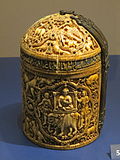Pyxis (vessel)
This article needs additional citations for verification. (November 2011) |

A pyxis (Green: πυξίς; pl.: pyxides) is a shape of vessel from the classical world, usually a cylindrical box with a separate lid. They were used to hold cosmetics, trinkets or jewellery, but were also used for dispensing incense and by physicians to contain medicine.[1] Surviving pyxides are mostly Greek pottery, but could also be made from a range of other materials: wood, bronze, ivory, marble, silver, or stone.[2] The name derived from Corinthian boxes made of wood from the tree puksos ("boxwood").[2] During the Classical period, the Attic word "kylichnis" was also used to refer to the same shape.[2] The shape of the vessel can be traced in pottery back to the Protogeometric period in Athens, however the Athenian pyxis has various shapes itself.
Types[edit]
There were many different varieties of pyxis, popular in different times and places. The earliest were the Protogeometric type of vessel which had a globular body, and the pointed-bottom pyxis from the early Geometric period.[3] The pointed pyxis didn't last much longer than the ninth century BCE. During the later Geometric period another style emerged with a flat, very broad base.[4] Contemporary scholarship classifies pyxides as either: type A, type B, type C, type D, lekanis, Nikosthenic, or tripod.[5]
Nikosthenic type[edit]
This type was introduced by Nikosthenes during the late sixth century BCE. It is characterised by a deep, calyx-shaped bowl with a flanged rim and a stemmed foot, and a domed lid.[6] The decorations on pyxides found in an Etruscan context tend towards depictions of battles and athletic contests; for pyxides found in Greek and near eastern Mediterranean settings the depictions tend to be of marriage, childbirth, or religious processions.[7] Evidence suggests that this was a popular type on the eastern Aegean island of Samos and in Etruria between 560–500 BCE.[8]
Gallery[edit]
- Pyxis made out of "Egyptian faience". Imported to Italy from northern Syria. Produced 750–700 BC, Altes Museum.
- Circular pyxis, 5th Century, Walters Art Museum
- An example of Roman luxury glassware, used to hold cosmetics or precious jewellery
- Horse pyxis
- 4th century Athenian pyxis with a depiction of a hand, National Museum, Warsaw
- Ivory pyxis from Córdoba, Spain, 10th Century AD, Victoria and Albert Museum
See also[edit]
References[edit]
- ^ Roberts 1978, p. 4.
- ^ a b c Roberts 1978, p. 2.
- ^ Folsom 1967, p. 180.
- ^ Folsom 1967, p. 181.
- ^ Perseus Encyclopedia, Pyxis
- ^ Lyons 2009, p. 166.
- ^ Lyons 2009, p. 171.
- ^ Lyons 2009, p. 173.
Bibliography[edit]
- Roberts, Sally (1978). The Attic Pyxis. Ares Publishers.
- Folsom, Robert (1967). Handbook Of Greek Pottery. New York Graphic Society Ltd.
- Lyons, Claire (2009). "Nikosthenic pyxides between Etruria and Greece". In Oakley, John; Palagia, Olga (eds.). Athenian Potters and Painters Volume II. Oxbow Books. pp. 166–180. ISBN 978-1-84217-350-3.


 French
French Deutsch
Deutsch





